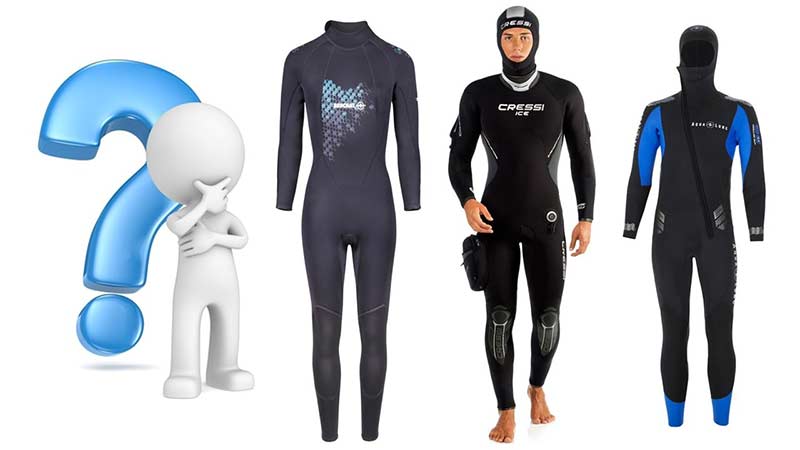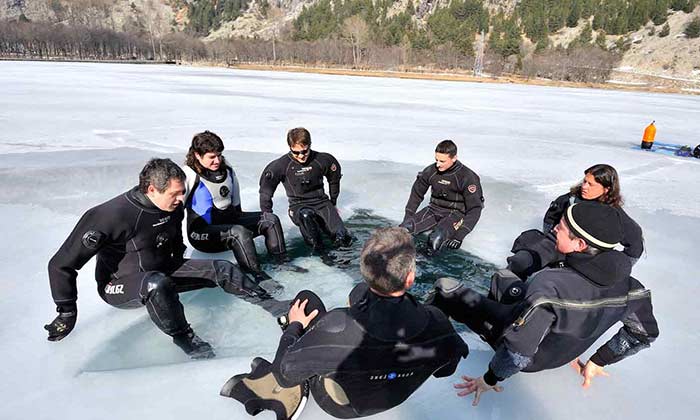Types of Diving Suits

Our protection is vital when it comes to any dive, and having the right clothing is the best way to ensure this.
In this case, choosing the best wetsuit among the different types of wetsuits available can seem like a challenge.
However, making the right choice is not impossible. You just need to consider factors such as the water temperature where you will be diving, the flexibility you need in the suit, the thickness of the material, etc.
In our post you will get to know all the parameters that distinguish them and we will also tell you what exactly you should look for in your next wetsuit according to your purposes and requirements.
Join us!
Why are Diving Suits so Important?
Wetsuits are an essential item when we start our dives. Remember that the best way to have a good time is to stay safe, and this is precisely what a good wetsuit allows us to do.
Its main function is to prevent the loss of body heat, because once in the water our body reduces its temperature rapidly(about 20 times faster than out of the water).
Thanks to this insulation we will be able to move more comfortably whatever the hot or cold conditions in the environment where we will be immersed.
But this is not all, as it is also a protective barrier against external dangers such as sharp rocks or underwater life.

Types of Wetsuit
There are different options when it comes to selecting a good wetsuit, as each one guarantees a level of protection adapted to a specific environment to provide maximum protection.
Here are the types of wetsuits you can choose from and their usefulness according to your requirements:

Wet Wetsuit or Wetsuit
Wetsuits are the most common type of wetsuit. They are named for their ability to trap a layer of water between the suit and the body.
In this way, with our body heat, it warms up and forms an excellent thermal barrier between the outside and the skin.
They are made of neoprene (in combination with nylon), a rubber polymer with air bubbles inside. The average thickness of these suits can range from 0.5 to 8 mm.
However, it is important to note that in this type of clothing, flexibility decreases with thickness. This will also be determined by the qualities of the cut and the neoprene.
In addition to being able to choose between different sizes for men, women and children, this category includes 2 alternatives:
- Short (shorty)
It is ideal for diving in tropical waters (24 to 28º C approximately), as it is a suit that covers the torso, arms and thighs.
The thickness of the material is generally around 1 to 4 mm, so it provides medium thermal insulation compared to the full suit.
Its function is to prevent chafing when carrying the rest of the diving equipment and, at the same time, to maintain the temperature in the trunk area.
In addition to being more comfortable and easier to put on, it can also be used for other water sports, such as surfing or snorkelling.
- Complete
This is the perfect type of wetsuit for diving in Lanzarote as it has temperate waters(with temperatures from 18 to 25º C approximately).
It is also the most widely used of the different types of wetsuits because of its ability to offer greater thermal insulation and better protection against bites and scratches.
The material is thicker in this case, about 5 to 7 mm thick.
For example, if you decide to dive in 20 to 27 degree water, the thickness of the wetsuit should be 4 to 6 mm.
In temperatures below 20 degrees Celsius, it should have a minimum of 7mm. A two-piece suit is also recommended for these situations.
There are options that even come with a hood to help protect us from the cold.
Depending on what is most comfortable for us, we can choose between one-piece and two-piece alternatives.
The former, being a single piece, is usually easier to put on and take off, as well as being more watertight when it comes to protecting us from the cold.
The two-piece option, on the other hand, is quite versatile. We can, for example, use the dungarees during the summer and, when winter arrives, add the jacket for diving in colder waters.
In this category we can find models such as the jumpsuit, which is made up of one piece and covers the entire legs; or the farmer John, which is similar to a pair of dungarees.

Semi-Dry Diving Wetsuits
Semi-dry wetsuits cover the whole body, are made of neoprene and are recommended for diving in cold or warm water(with temperatures from 10 to 23º C).
Unlike the wetsuit, this one has more watertight seals(with reinforced seals) on the zips, hands, neck and feet to minimise water ingress/egress.
This is how it achieves a significant improvement in thermal insulation, as there is less water flow, so the water stays in the suit longer and stays warmer for longer.
It is important to note that in these suits the zip will be positioned transversely, rather than vertically.
Therefore, you will need help if this piece is on your back. However, some divers argue that it is more convenient this way, as it avoids entanglement with other accessories.
They also consider that it contributes to a longer service life, because if the zip is in front, it will deform when folded(which is usually done by folding the sleeves forward).
Because of this, the location of the zip will depend on what is most suitable for you.
The hood is an essential element in semi-dry suits. Remember that the head is one of the parts of the body where we tend to lose the most heat, so keeping it covered will allow us to better conserve our body heat.

Dry Diving Suit
Dry wetsuits will allow you to dive in very cold water(temperatures of around 4 to 15°C). This is because they are completely watertight due to the presence of air inside.
By limiting water ingress as much as possible, the air between your body and the wetsuit will be heated to keep you warm. Therefore, among the many types of wetsuits, they are the most thermally insulated.
One of its main advantages is that you can regulate the amount of air that enters the suit, which, at the same time, will condition your level of buoyancy. For example, if we are going to ascend, we will have to release the air inside.
Mostly made of neoprene or trilaminate if used for technical or recreational diving.
However, each material has specific characteristics. For example, a wetsuit made of neoprene will be more flexible and will be able to fit better, as well as being more thermally insulating.
On the other hand, the trilaminate suit has the advantage of always being able to maintain the same buoyancy, making it ideal for maintaining neutral buoyancy.
It is an ideal suit for experienced divers who wish to dive in colder waters.

Buying Guide: How to choose the best wetsuit?
In addition to knowing the different types of wetsuits available on the market, it is vital to know what parameters you should follow in order to choose the best one for your needs.
Take note of the following data:
Thickness of the suit
This is one of the most important parameters, as it will allow you to be properly protected depending on the environment in which you are going to dive.
For example, if you dive in warm or tropical waters(temperature 24 to 25°C), it is best to choose a shorty with a thickness of 2 to 4 mm.
They are also the most suitable if you will be travelling a lot with it, as they take up very little space and are lightweight.
For diving in temperate waters (approx. 16 to 24°C), such as the Mediterranean Sea, a full 5 to 7 mm wetsuit is ideal.
On the other hand, if you are very sensitive to cold, will be diving in spring/autumn season or at a considerable depth, it is preferable that you select a semi-dry suit with a slightly thicker thickness of around 5 to 7.5mm.
In cold water(with a temperature of 5 to 16°C), the most suitable alternative would be a drysuit with a thickness of 7 mm. It can protect you perfectly if you are diving in mountain lakes, for example.
Finally, one thing to keep in mind is that if you see a suit with a thickness represented by 2 numbers (3/2 mm, for example), the first one will correspond to the thickness of the torso and the second one to the thickness of the arms and legs.
Wetsuit Size
A properly fitted suit will ensure that heat loss is minimal or non-existent. However, it should not be too tight, especially around the chest and neck, as you need to be able to breathe normally.
Equally, if you find it extremely difficult to put on, you may be wearing a size too small.
On the other hand, it is important for semi-dry suits that the ankle, neck and wrist cuffs fit snugly.
Another important point is to choose a suit designed for your gender, as they take into account the anatomical differences that exist and therefore fit better.
You should measure directly on the skin and, to take your measurements with a tape, make sure it is level all the way around.
On your chest, place the strap across the widest part of your chest and adjust it so that it is snug, but at the same time you can breathe normally.
At the waist, take measurements above the navel, which is the narrowest part of this area. As with the chest, you should adjust it progressively while breathing normally.
Finally, for the pelvis, place the tape on the widest part of your buttocks.
In case the 3 measurements do not match the same size, rely on the chest measurement, as it is the most important to ensure breathing comfort.
Manufacturing Material
Neoprene is the main material in many types of wetsuits. However, there are some variations in their finishes.
We tell you what they are, below:
- Smooth Finish
It is often used for the inner ankle and wrist cuffs of semi-dry wetsuits. This type of finish is very prone to tearing, so care must be taken not to pull it too hard.
It is also important to avoid digging your nails in when taking it off or putting it on.
- Lined
It is more resistant to tearing and therefore easier to take off or put on. It can have a towelling or nylon lining. Between the two, towelling is the more recommended material, as the terry cloth makes it more comfortable to slide over the skin.
- Titanium
This finish increases the thermal insulation. In these cases, the suit may have titanium plates placed between the lining and the neoprene.
Finally, it is best to look for a suit that is as flexible as possible, especially if it is semi-dry. This will make it much easier to put it on and take it off.
Reinforcements at the elbows and knees are also desirable, as these are the areas that suffer the most wear and tear and are the first to break.
Now that you know what the different types of wetsuits are and how to make the right purchase decision, do you already have your choice in mind?
We look forward to hearing from you in the comments if you would like to share your opinion, experience or if you have any questions. We will be happy to help you!

